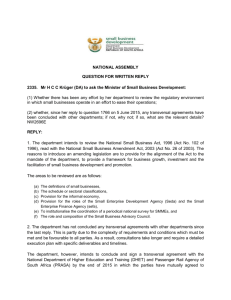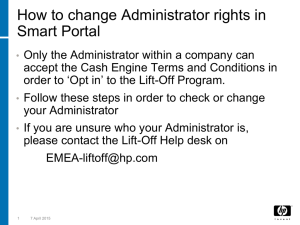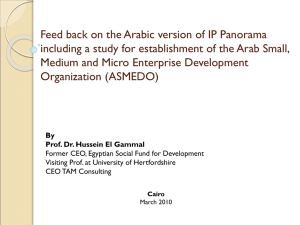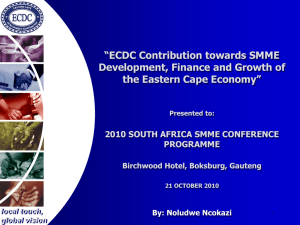Strategic Interventions required to improve Regional
advertisement
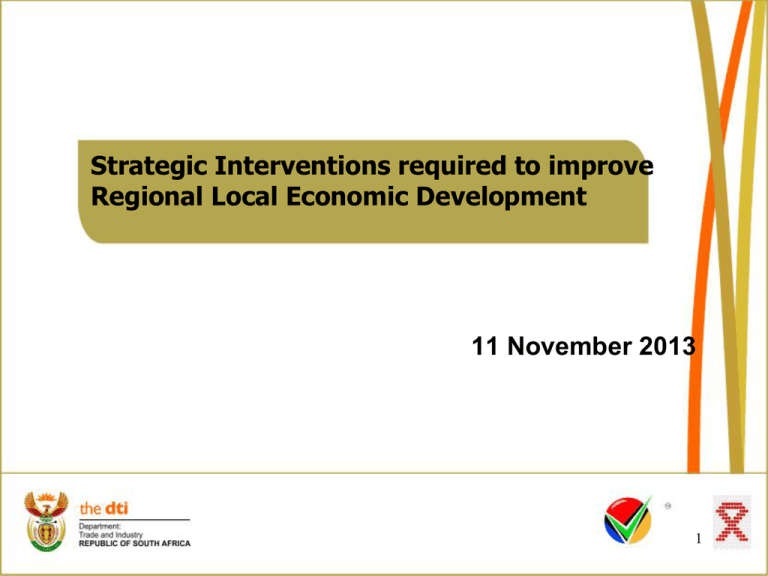
Strategic Interventions required to improve Regional Local Economic Development 11 November 2013 1 National Development Plan The National Development Plan has also made some key recommendations regarding what needs to be done for the country to be able to create 11 million jobs by 2030. Some of the urgent steps that need to be taken include: • • • • • • • Building partnerships between the public sector, business and labour to facilitate, direct and promote investment in labour-intensive areas Support for small businesses through better coordination of relevant agencies, development finance institutions, and public and private incubators Ensuring that South Africa’s rural communities have greater opportunities to participate fully in the economic, social and political life of the country. Institutional capacity building for local governments particularly strengthening their planning capabilities Developing neighbourhood spatial compacts to bring civil society, business and the state together to solve problems Strengthen local governments implementing capacity Ensure a pragmatic fit between roles and capacity, and rendering more support to the under-capacitated and mostly rural municipalities 2 Some of the LED Functions as defined by the Municipal Demarcation Board include: • setting up an effective ‘platform’ for enterprises to function effectively largely through effective municipal services, • providing information relating to the local economy, • promoting partnerships between public bodies and between the public and private sectors, • marketing the municipality as a business location, and • supporting emerging enterprises. 3 Strategic Interventions • Supplier Development Programme – – – – • Identifying opportunities for enterprise development in infrastructure DPE’s Competitive Supplier Development Programme (SOE) Capacity Building Programme, Benchmarking & best practice guidelines the dti –UNDP supplier development programme: 9-10 months mentorship intervention to selected cooperatives and SMMEs with the purpose of integrating to the value chains of big companies Local Support for SMME development – Set asides – Procurement • Business Retention and Expansion Programme – 60-80% of new jobs are created by the growth of existing businesses – Business profile – Skills Hub • Regional Industrial Development Strategy – Regional Industrial Clusters – Industrial and enterprise infrastructure (SEZs, Industrial Parks, Hubs, etc) – Small scale or village industries 4 Strategic Interventions continued...1 • Innovation and Technology Programme – Technology Industrial Platforms (Medium to high tech) Promoting technological innovation in SA’s industry, and to develop collaboration frameworks focused on increasing investment in technology development, diffusion and commercialization. Its mission is to enhance industrial development and competitiveness through technology support - Specialized Industrial Platforms(Medium to low tech) Create small production facility with equipment and machinery which enables different users in the same sector to produce products/processes/services with ease thus increasing productivity • Centre for Entrepreneurship – the dti programme to establish platforms with FET Colleges to develop local entrepreneurs that would establish and sustain viable and competitive businesses (Ekurhuleni-welding & waste management), (King Hintsa, Butterworth- Agriculture), (Mthatha –fashion design) 5 Strategic Interventions continued.....2 • Integrated SMME Action Plan – Increase and expand demand for goods and services produced by small businesses and Cooperatives – Continue to enhance efficiencies on support measures provided to SMMEs & Co-ops – Ensure active participation of SMMEs and Co-ops in the priority sectors identified in IPAP and NGP – Reduce regulatory burden facing SMMEs & Co-ops – Upscale and fast-track development of youth & women-owned enterprises 6 Informal Business Upliftment Instruments • Shared Facility Infrastructure – Cover the funding of a common infrastructure (new, upgrade or maintenance) – 50:50 contribution with municipality (capped at R2 million) • Upliftment for Microenterprise intervention – Targeting informal businesses prioritising Women, Youth and People with disabilities based in townships, rural areas and depressed areas (Skills, infrastructure support) tools and equipment (capped at R60 000-00) – Delivery partners (support for municipalities & chambers) • Informal Trader Upliftment Project – A partnership programme that offers skills and infrastructure support for entrepreneurs who are Street traders, home based (spazas), general dealers and those trading in markets 7 Incentive Schemes CLUSTER BROADENING PARTICIPATION INCENTIVE SCHEME • Black Business Supplier Development Programme (BBSDP) • Co-operative Incentive Scheme (CIS) • Incubator Support Programme (ISP) COMPETITIVENESS • Sector Specific Assistance Scheme (SSAS) INVESTMENT • Export Marketing & Investment Assistance (EMIA) MANUFACTURING INVESTMENT • • • • • Manufacturing Investment Programme (MIP) Capital Projects Feasibility Programme (CPFP) 12i Tax Incentive Automotive Incentive Scheme (AIS) Manufacturing Competitiveness Enhancement Programme SERVICES INVESTMENT • Film & Television Production • Business Process Services (BPS) • Tourism Support Programme (TSP) INFRASTRUCTURE INVESTMENT • Critical Infrastructure Programme (CIP) • IDZs (SEZ) Critical Infrastructure Programme A 70:30 cost-sharing grant scheme intended to leverage strategic investment projects (green and brown fields) by financially supporting infrastructure critical to such projects, enabling them to establish Qualifying Projects Transport systems Electricity and distribution systems Telecommunications systems Transmission systems . Sewage systems Waste storage, disposal and treatment systems Fuel supply systems 9 Capacity building programme • The programme comprises of – a four-year Degree, – short learning programmes. – Postgraduate and Masters (currently offered by UKZN) – Mentorship and training (municipalities) 10 Thank You ! 11


